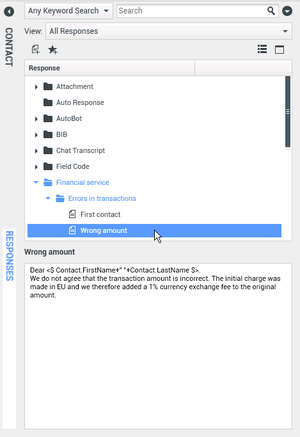Responses
[Modified: 8.5.109.16, 8.5.118.10]
The Responses view enables you to access a database of prewritten standard responses for your interactions. You can insert these responses as replies into any outbound interaction, such as an email or a chat message, or you can read them to the contact during a phone interaction.
After inserting a response into an outbound interaction, such as an email or a chat message, you can modify the contents of the text.
Use the Zoom control in the Main Menu (refer to Manage your settings and preferences) to change the size of the text in this view. This feature might not be available in your environment.[Added: 8.5.109.16]
To access the Responses view, click the vertical RESPONSES button on the active-interaction window.
The Responses view comprises two main areas, the Search and Filter area and the Responses Explorer.
Search and Filter
The Search and Filter area enables you to specify keywords for which to search in your organization's Standard Response Library. It has the following features:
- Search field: Enter the keyword for which you want to search, and click the magnifying-glass icon to initiate the search.
- Search type: A drop-down list that enables you to search using one of the following strategies:
- Any Keyword Search: Find all responses that contain at least one of the specified keywords.
- All Keyword Search: Find all responses that contain all of the specified keywords.
- Exact Text Search: Find all responses that contain the specified keywords in the order in which they are specified.
- Basic/Advanced Search: Specify where to search for the specified keywords; enables you to limit or expand the search.
- Responses Names: Search for the keywords in the names of the responses.
- Responses Body Text: Search for the keywords in the body of the responses.
- View: A drop-down list that enables you to view:
- All Responses: All of the prewritten responses that are available for you to use.
- Favorite Responses: Those prewritten responses that you have designated as favorites.
- Responses with predefined Shortcut: Those prewritten responses that have an associated shortcut keywords.
- Suggested Responses: Responses are selected automatically, based on categories, and sorted according to their relevance to the content of the incoming interaction. You can select an auto-suggest response and insert it into your reply. Then, you can modify the text of the auto-suggest response as necessary. Responses are ranked according to their relevance to the incoming interaction. You can choose to sort by Response name, Relevance, or Parent category by clicking the respective column head in the Responses List view.
Responses Explorer
The Responses Explorer contains a tree view of folders (standard-response categories) and pages (standard-response documents). You can change the view to a sortable table view of response documents and Parent Category folders.
The Responses Explorer enables you to:
- View the responses that meet the criteria that you have specified in the Search and Filter area.
- Navigate the responses folders and documents by clicking folders to open or close them and clicking documents to select them.
- Insert the response into your interaction at the insertion point by one of the following methods:
- Press Enter on your keyboard.
- Click Insert Standard Response Text (
 ).
). - Right-click the response and select Insert Standard Response Text from the context menu.
- Double-click a response to automatically insert the content at the insertion point in the text field. [Added: 8.5.105.12]
- Add the currently selected response document to your list of favorites by clicking Add Standard Response into Favorites Responses (
 ).
). - Remove the currently selected response document from your list of favorites by clicking Remove Standard Response from Favorites Responses (
 ).
). - Show results in List view or in Tree view by clicking the View Mode button (
 ).
). - Show and hide the responses details area by clicking the Show Detail/Hide Detail (
 ) button.
) button. - View the contents of the selected response document in the responses details area.
- Copy content from the responses details area and paste it into the message area of your email or chat interaction.
Responses Shortcuts
[Added: 8.5.118.10]
Your system might be set up to enable you to type shortcut keywords into the text composition field of email, chat, and other interactions that automatically add common responses to your interactions.
Ask your administrator or supervisor what the shortcut keywords are for your organization.
If a response has a shortcut keyword associated with it, when you select the response in the Responses view, the shortcut keyword is displayed above the preview and in the Shortcut column of the responses tree.
To use a shortcut, type the prefix specified by your company (for example, "#") followed by the keyword for the response you want to insert, followed by Ctrl+Space. If your prefix is "#" and the keyword is "sale", then you type: #sale+Ctrl+Space
Watch the video: Using standard response shortcut keywords
Related Resources
The Workspace Desktop Edition User's Guide (English only) provides detailed lessons for using all the features of Workspace. You might find the following lessons useful:

